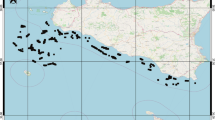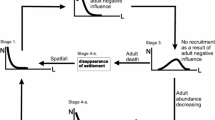Abstract
Models of marine ecosystem dynamics play an important role in revealing the evolution mechanisms of marine ecosystems and in forecasting their future changes. Most traditional ecological dynamics models are established based on basic physical and biological laws, and have obvious dynamic characteristics and ecological significance. However, they are not flexible enough for the variability of environment conditions and ecological processes found in offshore marine areas, where it is often difficult to obtain parameters for the model, and the precision of the model is often low. In this paper, a new modeling method is introduced, which aims to establish an evolution model of marine ecosystems by coupling statistics with differential dynamics. Firstly, we outline the basic concept and method of inverse modeling of marine ecosystems. Then we set up a statistical dynamics model of marine ecosystems evolution according to annual ecological observation data from Jiaozhou Bay. This was done under the forcing conditions of sea surface temperature and surface irradiance and considering the state variables of phytoplankton, zooplankton and nutrients. This model is dynamic, makes the best of field observation data, and the average predicted precision can reach 90% or higher. A simpler model can be easily obtained through eliminating the terms with smaller contributions according to the weight coefficients of model differential items. The method proposed in this paper avoids the difficulties of obtaining and optimizing parameters, which exist in traditional research, and it provides a new path for research of marine ecological dynamics.
Similar content being viewed by others
References
Chen C. 2003. Marine Ecosystem Dynamics and Modeling, New Frontiers of Sciences. High Education Press, Beijing, China. p.1–404. (in Chinese)
Chou J F. 2007. Way to innovation of numerical weather forecast: from initial value problem to inverse problem. Acta Meteorologica Sinica, 65(5): 673–682.
Chou J F. 1986. Why to combine statistical and differential methods and how to combine? Plateau Meteorology, 5(4): 367–372.
Ding D W, Shi H H, Zhang X L et al. 2009. The Mechanism of Water Quality in Offshore and Its Environmental Effect. Ocean Press, Beijing, China. p.1–280. (in Chinese)
Eldridge P, Jackson G. 1993. Benthic trophic dynamics in California coastal basin and continental slope communities inferred using inverse analysis. Mar. Ecol. Prog. Ser., 99: 115–135.
Fransz H G, Verhagen J H G. 1985. Modelling research on the production cycle of phytoplanton in the southern Bight of North Sea in relation to river-bome nutrient loads. Neth. J. Sea Res., 19: 241–250.
Franks P J S, Chen C. 1996. Plankton production in tidal fronts: a model of Georges Bank in summer. Journal of Marine Research, 54: 631–651.
Gao M, Shi H H, Li Z Z. 2009. Chaos in a seasonally and periodically forced phytoplankton-zooplankton system. Nonlinear Analysis: Real World Applications, 10: 1 643–1 650.
Huang J P, Yi Y H. 1991. Inverted modeling of nonlinear dynamics model using observed data. Science in China Series B, (3): 331–336.
Kones J K, Soetaert K, Oevelen D et al. 2006. Gaining insight into food webs reconstructed by the inverse method. Journal of Marine Systems, 60: 153–166.
Li H, Hou G, Feng D et al. 2007. Prediction and elucidation of the population dynamics of Microcystis spp. in Lake Dianchi (China) by means of artificial neural networks. Ecological informatics, 2: 184–192.
Lin Z S, Shi F B, Wang H. 1995. The retrieved model of Tianjin local climate. Acta Meteorologica Sinica, 53(1): 115–121.
Lyche A, Andersen T, Christoffersen K, Hessen D, Berger H P, Klysner A. 1996. Mesocosm tracer studies: 1. Zooplankton as sources and sinks in the pelagic phosphorous cycle of a mesotrophic lake. Limnol. Oceanogr. 41: 460–474.
Matsinos Y G, Troumbis A Y. 2002. Modeling competition, dispersal and effects of disturbance in the dynamics of a grassland community using a cellular automaton model. Ecological Modelling, 149: 71–83.
Niquil, N, Jackson G, Legendre L, Delesalle B. 1998. Inversemodel analysis of the planktonic food web of Takapoto Atoll (French Polynesia). Mar. Ecol. Prog. Ser., 165: 17–29.
Olden J D. 2000. An artificial neural network approach for studying phytoplankton succession. Hydrobiologia, 436: 131–143.
Ou D F. 2000. The Weierstrass Theorem on Rn. Journal of Changsha University of Electric (Natural Science), 15(1): 20–21. (in Chinese)
Vézina A F, Pahlow M. 2003. Reconstruction of ecosystem flows using inverse methods: how well do they work? Journal of Marine Systems, 40–41: 55–77.
Vézina A, Savenkoff C. 1999. Carbon and nitrogen flows in the surface layer of the NE Pacific. Deep-Sea Res., 46: 2 909–2 939.
Wang H L, Feng J F. 2006. Ecosystem Dynamics and Forecasting of Algal Blooms. Tianjin University Press, Tianjin, China. p.279. (in Chinese)
Wang Z Y. 2007. Modeling and Analysis of the Change of Plankton Ecosystem in Jiaozhou Bay for 40 Years. MS. thesis. Ocean University of China. (in Chinese)
Author information
Authors and Affiliations
Corresponding author
Additional information
Supported by the National Basic Research Program of China (973 Program) (No. 2010CB428703), Oceanic Science Fund for Young Scholar of SOA (Nos. 2010225, 2010118), Public Science and Technology Research Funds Projects of Ocean of China (Nos. 201005008, 201005009), and Open Fund of MOIDAT (No. 201011)
Rights and permissions
About this article
Cite this article
Shi, H., Wang, Z., Fang, G. et al. A statistical dynamics model of the marine ecosystem and its application in Jiaozhou Bay. Chin. J. Ocean. Limnol. 29, 905–911 (2011). https://doi.org/10.1007/s00343-011-0520-x
Received:
Accepted:
Published:
Issue Date:
DOI: https://doi.org/10.1007/s00343-011-0520-x




